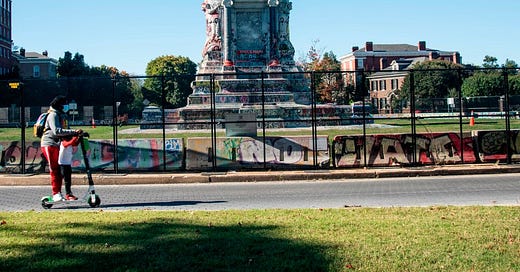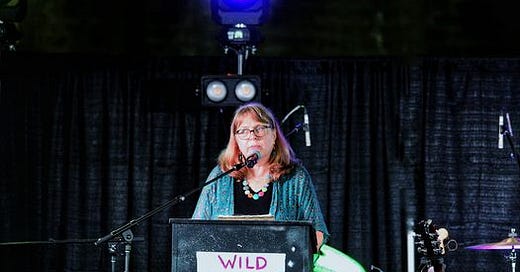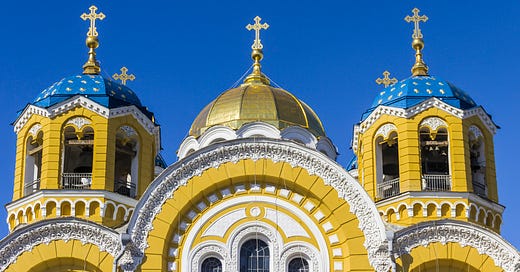

Discover more from The Cottage
Today is Ash Wednesday. Welcome to this season of reflection and our 2023 exploration of EMPTY ALTARS.
For information about signing up for the class offered in partnership with Homebrewed Christianity, please see below today’s post. And I hope you’ll join in.

Most days, I drive over a spot in a road where a statue was once located. Since 1889, a Confederate soldier stood on a high podium in the middle of the busy intersection of Prince and Washington streets in Alexandria, Virginia.
My family nicknamed that statue the “dejected Confederate,” because the lone soldier faced southward, his back turned on Washington, D.C., as he gazed down on passers-by with a look of dispirited contempt. The statue’s real name was Appomattox, a memorial to honor Alexandria’s Civil War dead – “They died in the consciousness of duty faithfully performed,” proclaimed an inscription on the base – placed by the United Confederate Veterans. Those who erected the sad soldier guessed it would be controversial from the start. Six months after its dedication, the United Confederate Veterans convinced the Virginia House of Delegates to protect the statue against alternation or removal in perpetuity.
He's gone now, after much argument and several changes to the law. In June 2020, a month before the city was set to remove the statue, the United Daughters of the Confederacy took him down and secreted him off to an undisclosed location. For several months, his podium remained. But that is now gone as well. The city paved over the foundation so cars can move freely through the intersection. Nothing remains of the dejected Confederate.
* * * * *
That statue is only one of the many memorials recently removed from public places in Virginia. The fight to take down the Robert E. Lee statue in Charlottesville resulted in neo-Nazis and white supremacists invading the university town and ended with a murder. Weeks of dramatic protests in Richmond, Virginia’s capital and once the capital of the Confederacy itself, led to the dismantling of the many statues that once constituted Monument Avenue, a wide boulevard of multiple circles with memorials dedicated to the leaders of the defeated southern army.
After the Richmond bronzes had been removed, I was in the city speaking at a church. The pastor, a religious leader who agreed with their removal, asked me: “Have you driven down Monument Avenue yet?”
“No,” I replied, “I haven’t been there recently.”
“It is stark, emotionally powerful in a different way than it used to be,” he said. “You look down the road and the statues are all gone. There are empty altars everywhere.”
Empty altars everywhere.
Yes, indeed. There are empty altars everywhere.
* * * * *
Some Christians are angry about the statues coming down and believe the removal of such monuments is a repudiation of history. But those Christians don’t understand history very well — because Christianity has always had an iconoclastic tendency. Since 300 C.E. or so, Christians have ripped down statues — political and religious images they considered morally corrupt or theologically suspect. The heroes and saints glorified in stone put up by one generation were often targeted by their own grandchildren or great-grandchildren who came to believe that the old ways needed reform — and gleefully stripped the altars of church and state to make way for a new thing.
And it isn’t just an occasional Christian tendency toward actual iconoclastic vandalism and violence.
* * * * *
Lent, the most somber season of the Christian year, begins with a reminder that everything is dust — and ends with the stripping of the altars. Some forty days from now, on Holy Thursday, after the liturgy re-enacts the Last Supper, sanctuaries will be darkened as priests and altar guilds remove every image, icon, and sacred element from the church and cover whatever remains in black. That liturgy is a kind of ritual iconoclasm — taking everything away that might distract us from confronting ultimate questions and the unnerving moment of being present with God and God alone.
During the weeks of Lent, Christians walk with increasing spiritual intensity toward the Empty Altar of Good Friday.
Ever since the Richmond pastor uttered those words, “There are empty altars everywhere,” I’ve not been able to get them out of my mind. I’ve thought a great deal about the history of iconoclasm — and how so many renewals and reforms begin with taking down statues and stripping altars. One can’t be a Protestant, for example, without having at least a bit of sympathy for iconoclasts. None of our churches would even exist without this strangely human impulse to clear the sacred decks of that which clutters the soul.
Years ago, my friend, the late Phyllis Tickle, used to speak of how the church needed periodic rummage sales in order to make way for new forms of faith. She believed that the church cleared out their buildings once every five hundred years or so — and she firmly believed that we Christians were in the midst of yet another giant flea market in the early twenty-first century. But she passed away before Charlottesville — before iconoclasm began in earnest beyond church yards — and spilled out into our public spaces and political arguments about statues and icons and history books. Frankly, I don’t think that Phyllis, who was from Memphis, would have minded that we’re fighting about both theology and shrines to Nathan Bedford Forrest (the first Grand Wizard of the Klan). Indeed, I suspect she’d be pleased to see those confederate statues coming down across her beloved southern city.
This Ash Wednesday reminds me that we live in a Lenten sort of time: There are empty altars everywhere. Church altars. The altars of our public squares. Things we thought were permanent are nothing but dust after all. Even the dejected Confederate protected in perpetuity by the legislation from the Virginia House of Delegates.
Ash Wednesday invites us to accept this truth of human existence — we are dust, what we build is dust, and sometimes you have to clean out the attic.
Yet there’s a concurrent truth in all this: dust matters because it is the very stuff of creation. Eventually, we’ll put something up on those empty altars. Human beings hate empty altars. We’ll create beautiful new things to express our hopes and dreams for the future. And we’ll make them from the dust of an older age.
The question for us: What will we make of the dust we’ve been given?
Welcome to Lent. Dust and iconoclasm. Endings and beginnings. Everything falls — or is felled — to dust. And from dust, the world is remade.
This Lent, The Cottage explores the EMPTY ALTARS of our days.
We are living in a time of iconoclasm. We've stripped the altars of both state and church. America's spiritual landscape is now marked by empty altars everywhere.
What does it mean to live in such an age? And what comes next? Will we put up new icons? Who are saints and heroes who speak beyond our cynicism? Who can inspire us to move ahead with joy, hope, and courage? Can we reimagine the sacred spaces in which we live?
We’ll explore EMPTY ALTARS in TWO WAYS:
1. WEEKLY DEVOTIONAL REFLECTIONS and conversation threads for paid subscribers at The Cottage. “Empty Altars” is the theme of my next book project — so you’ll be getting a preview of what I’m working in the form of inspirational material for your Lenten journey.
If you aren’t already a paid subscriber and want to receive the Empty Altars devotional reflections, please upgrade here:
2. An EMPTY ALTARS online class with me and Tripp Fuller. The Cottage and Homebrewed Christianity are teaming up once again for a mind-blowing, heart-expanding class this Lent — and our focus this year is history, spirituality, and social change. The course will begin on Monday, February 27. THE CLASS REQUIRES A SEPARATE SIGN-UP HERE — and is offered for free. Voluntary donations are welcome.
Here’s a quick preview of the class:
If you want the ENTIRE EXPERIENCE, make sure you are registered for the class AND have a Cottage paid subscription. The registration and the subscription will give you full access to everything!
Of course, you are welcome to do one without the other — they are complimentary explorations but each is beneficial on its own.
INSPIRATION
I met a traveller from an antique land,
Who said—“Two vast and trunkless legs of stone
Stand in the desert. . . . Near them, on the sand,
Half sunk a shattered visage lies, whose frown,
And wrinkled lip, and sneer of cold command,
Tell that its sculptor well those passions read
Which yet survive, stamped on these lifeless things,
The hand that mocked them, and the heart that fed;
And on the pedestal, these words appear:
My name is Ozymandias, King of Kings;
Look on my Works, ye Mighty, and despair!
Nothing beside remains. Round the decay
Of that colossal Wreck, boundless and bare
The lone and level sands stretch far away.”
— Percy Bysshe Shelley
It is my Lent to break my Lent,
To eat when I would fast,
To know when slender strength is spent,
Take shelter from the blast
When I would run with wind and rain,
To sleep when I would watch.
It is my Lent to smile at pain
But not ignore its touch.
It is my Lent to listen well
When I would be alone,
To talk when I would rather dwell
In silence, turn from none
Who call on me, to try to see
That what is truly meant
Is not my choice. If Christ’s I’d be
It’s thus I’ll keep my Lent.
— Madeleine L’Engle, For Lent 1966
This morning or at lunch or this evening, Christians all over the world will go to their church buildings and sit among their fellow-congregants and say the words of the ancient prayers and then receive the mark of the cross written in ashes on their foreheads. Ruthe (a shut-in friend) can’t do that, and I won’t. Instead, in just a little while, I will go to her house, my eucharist kit in hand, and I will spread the communion vessels and gifts there on a small table she has reserved for that use. Before I get there, however…and just about now, I suspect…Ruthe will have rolled herself over to the fireplace and begin our service even before I arrive.
Every year, on Palm Sunday, I carry home with me a palm cross or two, taking them to Ruthe on the following Wednesday. She saves them back in a special place, saves them against this day. She’ll take them with her today as she rolls to her fireplace; and she’ll burn them there. The cross triumphant is gone for these next almost seven weeks, the ashes of its loss becoming the visible signs of our sorrow. This afternoon, when I arrive, the burnt remains of last year’s glory will be in a tiny bowl on our small altar, waiting there for us. And we will say the prayers together and I will read the ancient scriptures foretelling this. Then Ruthe will take the little bowl, and we will lay upon each other’s foreheads the mark of our faith. After that, we will celebrate the mass, and I will go quietly home. There will be nothing left to say. It has begun again, this measuring of our years.
— Phyllis Tickle, “February 6, 2008: Ash Wednesday”
The New Evangelicals, one of the hottest religion podcasts right now, is aimed mostly at disgruntled and disillusioned young adults who grew up in evangelical churches. The New Evangelicals is about reforming, remaking, reimagining, and recuperating from what it means to be “evangelical” — or even “Christian.” Tim Whittaker, podcast host, asked me and Tripp Fuller to come on and talk about Lent for people who aren’t familiar with the church year. We wound up talking about empty altars, saints, Lent traditions, and death. CLICK HERE or on the box below to listen.
You’ll like it. Even if you aren’t a disgruntled evangelical. And it will surprise you as you consider Lent this year.

















Thank you Diana. I appreciate your articles as they make me think. Funny, though, my first thought to your question, "What will we make of the dust we've been given?" was mud pies! LOL! We could make mud pies. And that leads to my childhood memories. My brother and I would play in the soft soil around our field in Iowa and fill a bucket of water to make mud pies. We added weeds, leaves, bugs as that was our different seasonings I suppose. Bottom line, it bought me to ponder, what we make out of the dust given to us is by showing up. How do I want to show up each day in this world and show God's love? How do I want to be available to share my time, my creativity, my mud pies with the world around me? That's the meaning in the dust to me anyway. Blessings to you.
"Some keep the Sabbath going to Church
Emily Dickinson
Some keep the Sabbath going to Church –
I keep it, staying at Home –
With a Bobolink for a Chorister –
And an Orchard, for a Dome –
Some keep the Sabbath in Surplice –
I, just wear my Wings –
And instead of tolling the Bell, for Church,
Our little Sexton – sings.
God preaches, a noted Clergyman –
And the sermon is never long,
So instead of getting to Heaven, at last –
I’m going, all along."